Biostar TPower i55 – Super Middle Weight Contender
by Rajinder Gill on November 25, 2009 12:00 PM EST- Posted in
- Motherboards
Board Layout and Features

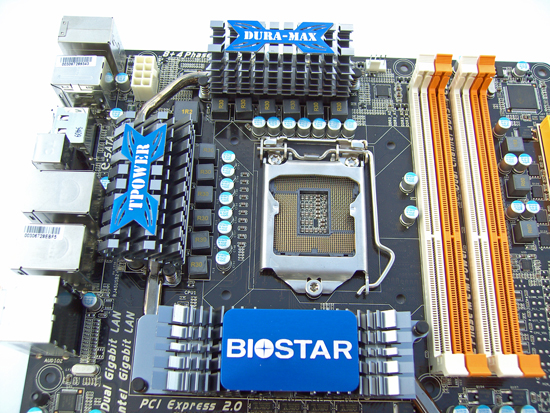
The heatsinks bearing the TPower and DURA-MAX logos provide cooling for the 8-phase uPI CPU PWM circuit, with an additional 4 phase supply for VTT (the integrated memory controller). The IR FET’s are specified at around 30 amps each, which should allow for ample overclocking headroom. The two CPU PWM heatsinks are connected by a heatpipe which also links to the BIOSTAR logo heatsink you see in the bottom of the picture. This pipe extends further to the PCH heatsink, allowing the entire assembly to be cooled with a single fan. All heatsinks are fastened with push-pins rather than screw fittings, although we found contact pressure was sufficient in this instance.
Despite the bulk used in these heatsinks, were going to recommend users to apply active cooling across the central heatsink when overclocking, especially if ramping PWM switching frequencies for heavy load testing. On the subject of heavy loads; BIOSTAR is using revised FOXCONN sockets on their boards. We’ve had no socket related problems during the course of this review and have not heard of any user reports thus far using BIOSTAR boards.
We’re a little surprised to find that there are only three onboard fan headers, one of which is assigned to the CPU. This leaves two (actually one) additional headers for active board cooling should high temperatures become a hindrance to overclocking. Do note; the SYS_FAN 2 header at the right side of the board will not be accessible if you plug a long GPU into the primary PEG slot. We’d like to have seen BIOSTAR put a little more time and consideration with regards to the number of headers and their placement on this motherboard given the target audience.
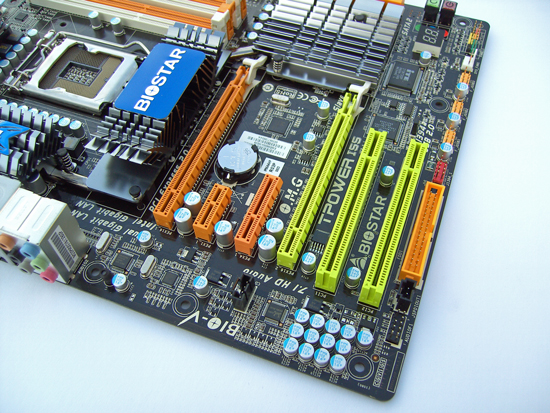
Expansion slot layout from the top down is comprised of, PCI/e x16 (x8 if the second x16 slot is filled), PCI/e x1, PCI/e x4, PCI/e x8 and two PCI slots at the bottom. You lose access to the PCI/ex 1 slot as soon as you put a GPU with a dual slot cooler in the first PEG slot, although you can use the PCI/e x4 slot instead. Running dual GPU’s will also limit users to one PCI slot, although we don’t see that as a huge deal breaker these days.
While we’re on the subject of expansion slots, we found the PCI/e retention latches to be a pain when trying to remove our 4870X2 GPU from the board. The lever does not protrude far enough to allow access easily, especially if the board is placed in a case. We had to use a set of long-nose pliers to grab the latch and force it downwards so that we could remove the GPU from the slot.
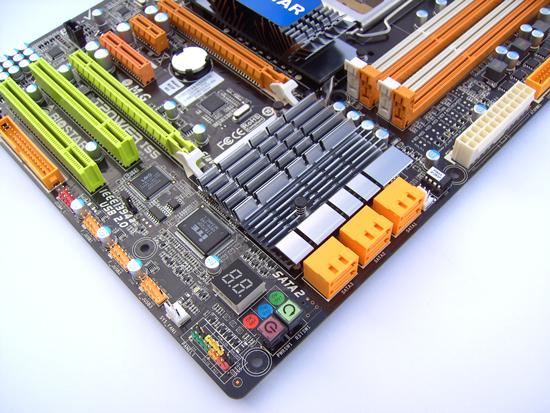
Six right angle SATA ports are available via the Intel P55 PCH. A LED hex post code reader and power/reset switches are located in the lower right corner for open test bed users. A single DIL socket BIOS chip is located above the SATA ports, while the associated CMOS clear jumper is located to the right of the last PCI slot. CMOS clear access is certainly going to be hampered somewhat if the last PCI slot is occupied, but we never needed it. Unfortunately there is no rear I/O panel CMOS clear switch, which will leave users pulling side panels off cases should the board fail to post after changing BIOS settings.
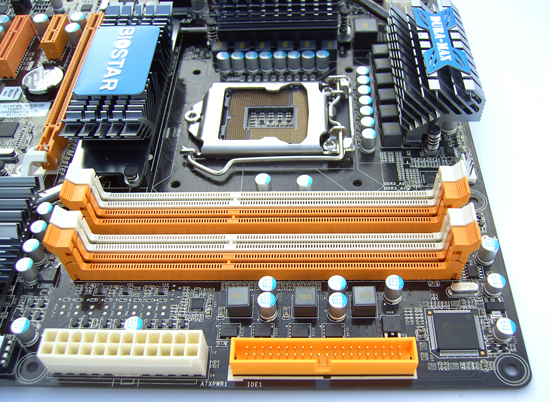
ATX 12V and IDE connectors are placed along the right edge of the board. A full spread of voltage reading pads are provided, and located between the ATX 12V connecter and the last DIMM slot. DIMM voltage is supplied by a 2-phase PWM circuit, which is pretty much the norm for boards in this price range and should certainly be more than adequate for the platform.
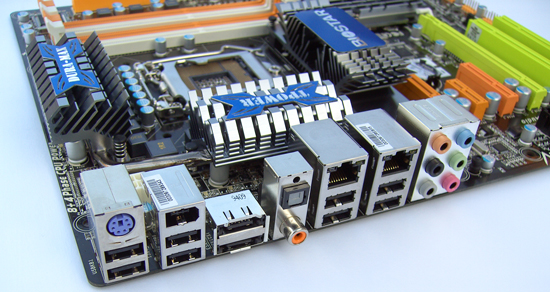
Rear I/O options include: 1 PS/2, 8 USB, 2 E-SATA, 1 IEEE-1394a, 2 RJ45 LAN, 1 S/PDIF & 1 Optical out and finally 6 AUDIO out jacks (Realtek ALC888).










39 Comments
View All Comments
bccloth00998 - Friday, December 18, 2009 - link
http://www.bccloth.com">http://www.bccloth.comzengqunhai2 - Saturday, December 12, 2009 - link
www.find68.comChristmas sale, free shipping discounts are beautifully gift
Christmas is approaching, your Christmas gifts ready? wownicesales
mall for you, which involves a number of well-known brands from the
Asia-Pacific region the trend of merchandise. Promotional discounts
should be, come SHOPPING bar!
In order to meet the arrival of Christmas. Our company has been in
order to return the old customers of the Company for their support.
Overall direct sales business. Wholesale price of a rare opportunity.
You are still hesitant about. Chance only once.
Not to be missed.
(I)Our Company is Online store, and we vogu emalls offer top quality
sport shoes, famous brand shoes and sportswear at good price.
(II) I n the past 6 years, we have sent great many products to the
customers in USA, Europe, ASIA and other area, also we have lots of
experience in dealing with online business oversea
(III) Generally, Goods are delivered in fast and safety way Of
course, shoes and clothing will be packaged in original box with tags
www.find68.com
New to Hong Kong : Winter Dress
---**** NHL Jersey Woman $ 40 ---**** NFL Jersey $ 35
---**** NBA Jersey $ 34 ---**** MLB Jersey $ 35
---**** Jordan Six Ring_m $36 ---**** Air Yeezy_m $ 45
---**** T-Shirt_m $ 25 ---**** Jacket_m $ 36
---**** Hoody_m $ 50 ---**** Manicure Set $ 20 ... ...
granulated - Friday, December 4, 2009 - link
I want to know how why the AMD board murders the rest in two games when it's in it's more usual 'bringing up the rear' position in the rest.ta2 - Monday, November 30, 2009 - link
Seems like you've been using a pretty crappy i5 chip. For it to top out as 4.1GHz is incredibly bad. I manage 4GHz on a GA-P55-UD4 with ALL voltages at stock except VCore at 1.30V. You have not really pushed the BCLK on this board and for you to need 1.36V for 4.1GHz is pretty terrible. I consider myself a novice overclocker, but either you're using a very bad chip or this board isn't so hot."We could run our memory at DDR3-2152". This board is officially rated up to 2600MHz for memory... so we haven't even tried to get close to the spec speed.
Rajinder Gill - Tuesday, December 1, 2009 - link
It's an average 750 CPU. There are plenty out there that top out early.With regards to 2600 MHz memory, I don't know of any CPU's that can hold 2600MHz speeds fully application stable. That's a benchmarking claim for users who run processors with sub zero cooling or like to post suicide shots. This article is focused on daily PC use. A BCLK of 215 is perfectly respectable for everyday usage scenarios (especialy with S3 resume working).
later
Raja
lopri - Friday, November 27, 2009 - link
The board looks really awesome. I mean, the fact one of the main gripes is the lack of clear CMOS button in the rear I/O panel says a lot. I like that Biostar used the Intel ethernet PHY to take advantage of ICH10R's built-in network controller. So many times I see CPU usages going 20~30% when there is heavy network trafficking, and I wondered why my experiences are so different from what I see in the reviews. Granted different packets show different performance characteristics and anti-virus is probably half of that CPU load, but the CPU usage wasn't as severe on my BadAxe 2 (which I use for WHS) so I do believe the Intel NIC/PHY is superior to that of Realtek.Another welcome news is the flawless S3 functionality under overclocking, and I applaud it very, very much. Board's layout looks extremely clean and logical as well. For me the downside of this board are the lack of fan headers and the price tag which can be (hopefully) rectified in the future.
Thank you for a thorough review (for a split second I thought Gary was the author, but please don't take offense ;) ) and I just might have found my next motherboard.
lopri - Saturday, November 28, 2009 - link
Well, actually I do have one more gripe. I am not a fan of daisy chained heatsinks, and on this board the heatsink with 'Biostar' written on it kinda sticks out. I'm guessing what's underneath are those 4 PCIe blocks often found bare on other boards. (?) How hot do they get and do you think it's justified to having a heatsink over it based on that? If not, I'd prefer to have more room for CPU HSF installation and video card installation.Rajinder Gill - Saturday, November 28, 2009 - link
Hi,The BIOSTAR logo sink does not really cover anything other than to add mass to the enitire assembly. Stock operating conditions, you could get away with passive use. If overclocking and raising PWM switching frequency(for whatever reason), while runnign a 'hot' GPU in the first slot, you'll probably want to cool the HS assembly depending on what kind of case you have. The lack of fan headers obviously does not help.
regards
Raja
lopri - Tuesday, December 1, 2009 - link
Thank you for the clarification. That said, since the board is kind of heavy on use of heatsinks, maybe they can use real screws instead of plastic push-pins? Faced with the Almighty AnandTech editors' advice, who knows? Biostar might listen. *wink* *wink*yuhong - Friday, November 27, 2009 - link
"It’s the first time in a long time we’ve not had to request fixes for peripherals or BIOS issues/tweaks to complete a benchmark, a welcome change indeed!"Yep, remember this:
http://www.anandtech.com/showdoc.aspx?i=3471">http://www.anandtech.com/showdoc.aspx?i=3471